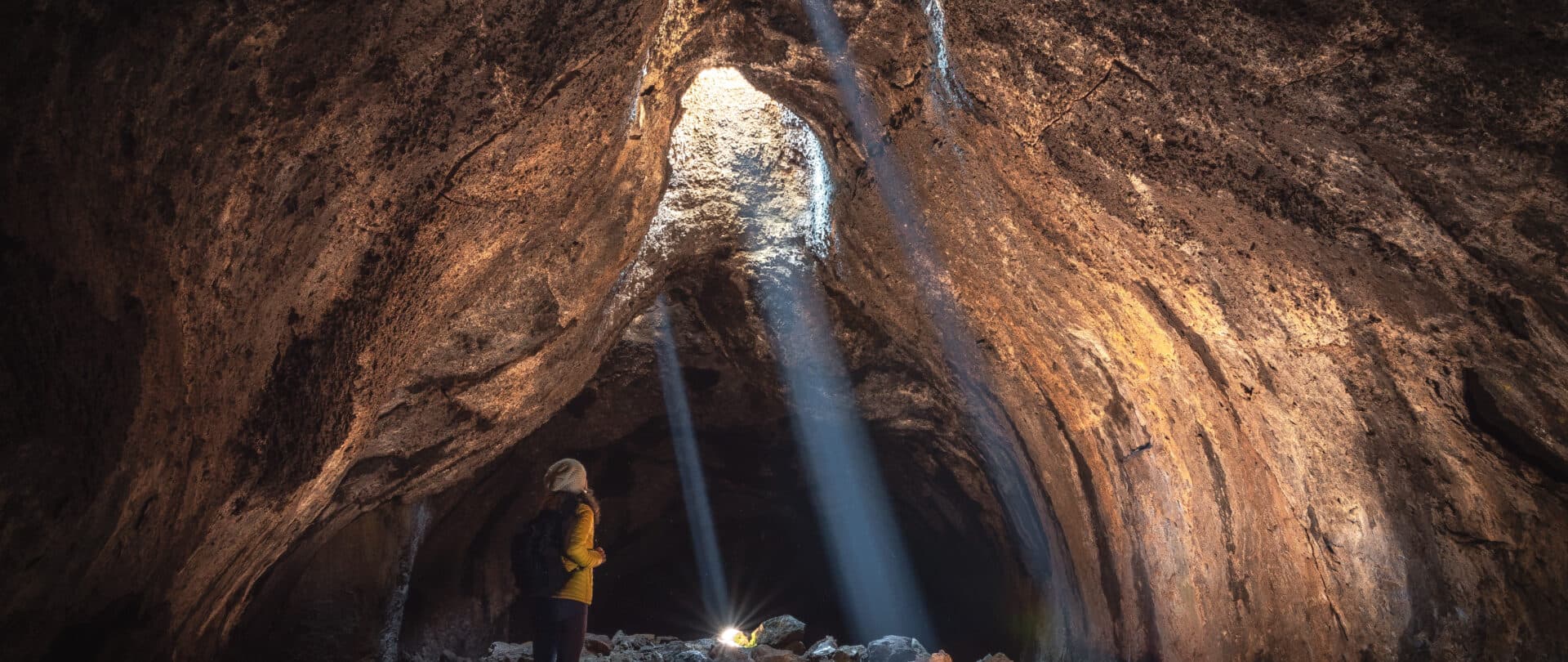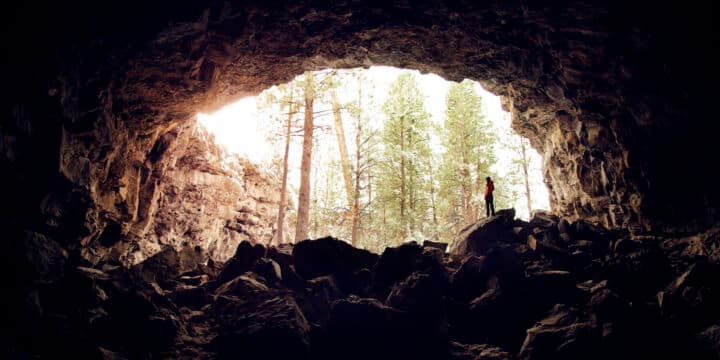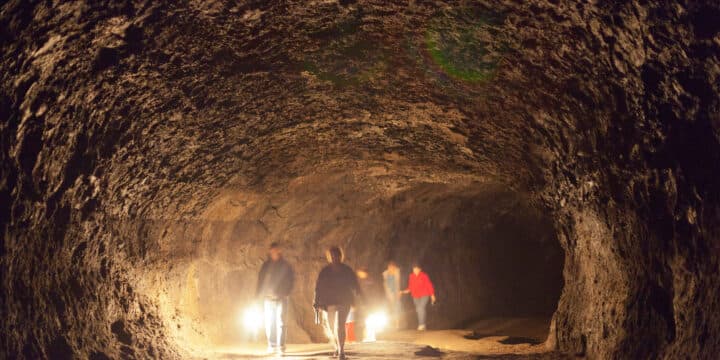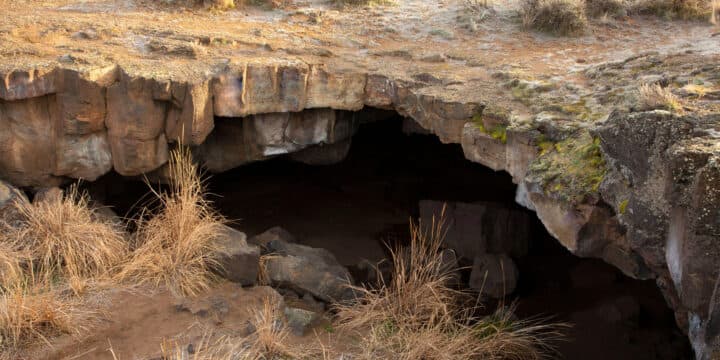
Into The Deep
Get underground and explore caves and lava tubes in Central Oregon
BY By Meghan Robins
Two Major Eruptions
Approximately 600,000 years ago, Newberry Volcano, an active volcano twenty miles south of Bend, began erupting on and off covering the landscape in hot lava flow. There were two major caldera-forming eruptions that created a massive hole now filled by Paulina Lake and East Lake, followed by hundreds of minor eruptions from different vents that resulted in various cinder cones and lava flows.
Newberry Volcano is named after naturalist Doctor John Strong Newberry who joined the U.S. Army Pacific Railroad Survey crew in the late 1850s. The volcano used to be a 9,000-foot-tall mountain with a roughly 25-mile-diameter base. Imagine looking south of Bend, where we now see the broken crown of Paulina Peak, and instead of seeing a fragmented ridgeline, seeing a mountain as tall as Mt. Bachelor.
Newberry’s string of volcanic events affected all of Central Oregon, including what is now Bend, Redmond, Prineville and as far north as the Crooked River and Smith Rock. Lava that blasted upwards solidified and fell through the air as tiny cinder particles, creating a multitude of cinder cones like Pilot Butte, Lava Butte and nearly 400 other hill-like cones that now pockmark the landscape.

Long-Standing Relationships with Humans
In the following thousands of years, volcanic activity continued to shape Central Oregon. Hundreds of lava caves were formed; rivers like the Deschutes were rerouted; and time, weather and erosion created beautifully dramatic landscapes. Archeological evidence suggests that Indigenous Peoples have been living in the Central Oregon area since at least 13,000 years ago. Since time immemorial, the area has been home to the Wasco (Wasq’u) and Warm Springs (Tana’ma) Nations, who along with the Northern Paiute (Numu) Nation make up the Confederated Tribes of Warm Springs.
According to Wilson Wewa, oral historian, storyteller and the great grandson of two Northern Paiute leaders Chief Weahwewa and Chief Paulina (after whom Paulina Lake is named), specific caves and lava sub-features comprise important cultural histories. In his book “Legends of the Northern Paiute,” Wewa tells an intricate story of how the crack in the earth currently known as Malheur Cave is where all of creation began. In addition to having meaningful cultural significance, caves have long served as places of refuge with consistent year-round temperatures providing warmth in winter and cooler reprieves in summer. Some of the oldest archaeological finds are in the Paisley Caves and Fort Rock Caves, suggesting that many of Central Oregon’s geological features have long-standing relationships with humans. Under the Treaty of 1855, Indigenous Nations maintain their rights to access caves and traditional lands for hunting and fishing and ceremonial purposes.

A Critical Balance Between Recreation and Habitat
Caves are also environmental sanctuaries and critical habitats for animals, especially raptors and bats. Many caves in Central Oregon have strict operating hours, seasonal access and regulations to protect bat and wildlife populations from deadly diseases like white nose fungus that fatally infects bats during hibernation. For this reason, it is critical for humans to be diligent in following regulations and rules before exploring underground. As caving has become more popular, new regulations and social expectations are being discussed and implemented to preserve these areas from overuse and unfortunately from vandalism and abuse.
Today, approximately 858 caves, 702 of them lava tubes, have been identified in Central Oregon, making caving one of the most fascinating adventures visitors and residents can experience. Imagine crawling between rocks for a few feet or walking underground for over a mile (Oregon’s longest reported cave is Lava River Cave at 2.2 miles round trip). While the geology behind how lava tubes are formed is complicated, Central Oregon boasts examples of some of the most fascinating volcanic features like lava tubes, vents, cinder cones, overhangs, rock fissures and more.
Oregon is the most volcanic state on the mainland (Hawaii is the most volcanic state overall), and much of Bend is built atop basalt lava flows from the Newberry Volcano eruptions. As the City of Bend grows and has expanded their Urban Growth Boundary, many caves and lava tubes have been built over, privatized or otherwise made inaccessible. But new caves are still being revealed. For example, in 2017 a couple purchased 10 acres just outside of Bend only to realize the small hole their realtor reported was a significant cave underneath the property. Volunteer experts from Oregon High Desert Grotto (OHDG), which is affiliated with the National Speleological Society, were called in and have spent much time studying the site.
The increase in vandalism has sparked vehement debate over who is allowed to access caves and in what way. Recreationalists like paddlers and rock climbers are eager to explore certain caves while some diehard cavers, historians and geologists want to preserve the natural state of caves for everyone’s long-term enjoyment. Such clashes have inspired the Deschutes National Forest to implement new regulations that include things like banning certain activities within 200 feet of cave entrances like music, bolting, slacklining, excavating, campfires, smoking, dog and human feces, glitter and more. In recent years, caves have endured graffiti over ancient petroglyphs, pollution of sensitive ecosystems and destruction of irreplaceable formations and features.
Because of this, lesser-known locations and access points have become coveted information. Volunteer groups like OHDG and other cave enthusiasts spend hours cleaning, preserving and protecting these valuable habitats and geological formations. They are not eager to let any secrets out.
Wanderlust Tours and OHDG partner with local breweries to host an annual community cave clean-up day every year on the second weekend in May. Volunteers pick up trash and remove graffiti then enjoy a cold beverage and s

How to Responsibly Explore Underground
Luckily for the novice caver or anyone eager to experience the cool eerie underground, there are a variety of self-guided and legal tour-guided caving options to choose from. For those interested in the complex and extensive geological history of Central Oregon, organizations like Oregon High Desert Grotto (OHDG), Central Oregon Community College’s Geology Department, the Central Oregon Geoscience Society and Wanderlust Tours offer great resources.
Wanderlust Tours out of Bend is the only permitted tour guide service offering year-round cave tours with professional guides, helmets, headlamps and shuttle rides included. Because caving is a hazardous, physical engagement with natural elements, no matter which activity you choose, be sure to read the tips section and always tell someone where you are going before stepping underground.
Self-Guided Caving Options
Redmond Caves (Daily Year-Round)
Just outside Redmond Airport (RDM) located on BLM (Bureau of Land Management) land are the Redmond Caves. Five short openings (one hundred feet or less) lead to one underground lava tube formed most likely by the Basalt of Bend eruption some 64,000 years ago. Like most lava tube caves, the Redmond Caves were revealed by geological collapse that provided convenient access points for humans to experience quick underground exploration. The Redmond Caves are open year-round, relatively unmaintained and do not require a permit or tour guide. Explorers should be prepared with warm clothes, proper closed-toe shoes — no sandals — and flashlights or headlamps regardless of time of day or year.
Lava River Cave (May-September)
A much more ambitious hike is the self-guided Lava River Cave, a 2.2-mile roundtrip lava tube at Newberry National Volcanic Monument just 15 miles south of Bend. The hike is open seasonally between mid-May through mid-September during park operating hours only. The protected area is managed by Deschutes National Forest, who manages parking fees and a visitor center with select gear rentals. Despite the name, water did not flow through this cave, though early speculators assumed so because of the spectacular “Sand Gardens” at the end. Give yourself at least 90 minutes to explore the human and geological stories of this fascinating national monument. As with all cave exploration, do not bring pets, wear unwashed clothes or bring used gear from one cave to another to protect this critical bat habitat from spreading deadly diseases like white-nose syndrome.
Skylight Cave (May-September)
In summer months between May and mid-September when Skylight Cave is open, the high summer sun pours down through three holes, which are collapsed sections of the lava tube’s ceiling. Enter by climbing down a ladder into a hole in the ground and explore over a thousand feet of cave. At the right time of day when the sun is shining, beams of light pour through the skylights, giving this cave its name. Located about 30 miles northwest of Bend, past the town of Sisters on the McKenzie Highway, Skylight Cave is a self-guided experience that includes moderate hiking, physically demanding access via ladder and unstable terrain.
Guided Caving Options
Wanderlust Tours with Naturalist Guides
Both experienced and novice underground explorers will benefit from hiring professional naturalist guides at Wanderlust Tours based out of Bend. Learn firsthand about geological and human history during their many three- or four-hour guided natural interpretation tours that include transportation, naturalist guide interpretation and safety equipment. Tours typically start at 9:00 am or 2:00 pm but can vary depending on the tour, cave location and season. Learn more at wanderlusttours.com.
Lava Tube Cave Tour (Daily Year-Round)
Tucked between ponderosa pines deep in the forest, this hard-to-find hole in the ground offers opportunities to crawl, scramble and explore on moderately difficult terrain. Because this cave area is typically open to the public, other groups may also be exploring at the same time. This daily offering is great for people ready to explore uneven and more difficult terrain any time of year.
Limited Entry Cave Tour (May-September)
Experience the eerie quiet of the dark underground with only a few other people and an expert naturalist guide. Because this cave is not accessible to the public, this caving experience is truly intimate and unique. With easier walking conditions on mostly level surfaces of sand, ash and rock, the Limited Entry Cave is great for multi-generational families.
Prohibition Cave Tour (Daily Year-Round)
Fifteen years before Oregon declared statehood (1859), squatters in Oregon Territory voted to prohibit alcohol in 1844. The vote was repealed in 1845 but reinstated in 1915. This prohibition aligned with the establishment of many Central Oregon timber mills, including Brooks Scanlon and Shevlin Hixon in 1916, which spurred a population boom. Many newcomers began distilling secretively in caves. The consistent underground temperature (caves still average 45 degrees) was perfect for cold storage, hideouts and bootlegging, which inspired Wanderlust Tours and Oregon Spirit Distillers to partner and create the Prohibition Tour. This daily tour begins with caving followed by a full distillery tour with spirits tasting and appetizers. For the thirsty yet adventurous explorer, this is a perfect pairing.
Starlight Cave Tour (April-May & October-November)
Central Oregon is a fantastic place for stargazing. Caving plus stargazing while learning from an expert naturalist guide is an experience to remember. The Starlight Cave Tour typically starts around 7:00 pm but varies based on daylight. The evening tour includes going into a cave then stargazing with fresh-baked desserts and hot drinks in the desert. Throughout the year Wanderlust Tours also offers naturalist-guided stargazing canoe trips in the summer and snowshoeing in the winter.
Accessibility & Community Givebacks
To increase accessibility to the outdoors, Wanderlust Tours offers a scholarship program and matches 100% of donations made to the fund. Guests may contribute either by phone or by adding a donation during the purchasing process. Scholarships are extended to nominated community members throughout the year, supporting those who may not be able to afford a naturalist guided tour.
In addition to public tours, Wanderlust Tours works with nonprofits and school groups to make the outdoors more accessible. If you have a question, idea or unique group situation, please reach out to them at wanderlusttours.com. Additional ways to get involved with Central Oregon’s community of cave-lovers is to volunteer throughout the year and especially at their annual cave clean-up day typically scheduled for the second weekend in May.
Unfortunately, because caving requires some degree of physical prowess to scramble over rocks, crawl through short passages or move over rough and variable terrain, Central Oregon does not yet have noteworthy accessibility options for caving. Many organizations are aware of this inequity and are brainstorming ways to better address accessibility issues.
Tips for Central Oregon Caving
If you’re going to explore Central Oregon’s caves, do so responsibly. Help protect precious resources and sensitive habitats and preserve the experience for others by following these general guidelines:
Never wear the same clothes or shoes into two different caves or mines to prevent the spread of white-note syndrome, a deadly disease for bats.
Caves are cold! Always be prepared with layers and a jacket, regardless of time of year.
Caves are dark! Bring multiple light sources: two to three flashlights or headlamps are recommended per person.
Helmets are recommended for safety, as cave exploration includes unstable footing and possibly falling debris.
Do not go alone. Cave exploring is dangerous and best done with a partner.
Always tell someone where you are going and when you plan to return.
Wear close-toed stable shoes and be prepared to crawl, scramble or climb to get in, out and through caves.
Be respectful of seasonal closures, which are largely in place to protect sensitive habitat, breeding and hibernation areas.
Always check local regulations, rules and hours before planning your trip.
As with any service industry, extending gratuity to exceptional service personnel and tour guides is not required but always appreciated.
